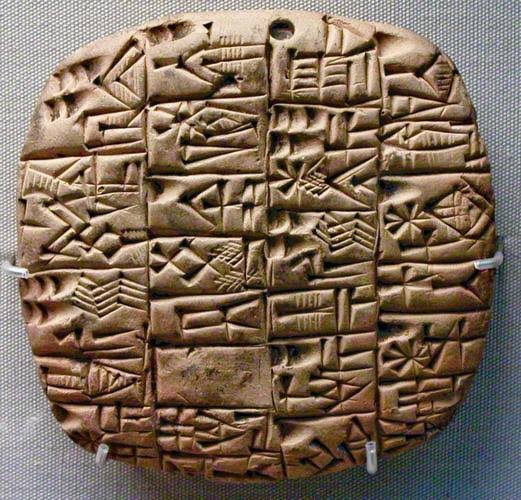
@quant_network provides a simple, efficient, and effective solution to the lack of interoperability among distributed ledger technologies (DLTs).
But, what are DLTs?
I made this thread to breakdown what a DLT is and the benefits it provides to the community.
#QNTTalent
But, what are DLTs?
I made this thread to breakdown what a DLT is and the benefits it provides to the community.
#QNTTalent

Simply put, a ledger is a collection of books in which transactions are recorded for documentation and safety purposes.
According to history, the most primitive form of ledger organization was started by the Mesopotamians many years ago.

According to history, the most primitive form of ledger organization was started by the Mesopotamians many years ago.


At that time, items and quantities are entered on clay tablets known as cuneiform.
This ledger captured ownership which gave room for transactions to occur by leveraging on these cuneiforms.
However, this kind of ledger wasn't sustainable for long-distance transactions and this led to the birth of a double-entry ledger.
However, this kind of ledger wasn't sustainable for long-distance transactions and this led to the birth of a double-entry ledger.
This ledger introduced the concept of debit and credit which allowed banks and institutions to create a centralized ledger that they solely control similar to when business owners take down their daily stock to check money inflow and outflows.
With the invention of computers and digital advancements, computers took over centralized ledgers from paper recordings.
However, to promote transparency and remove third-party influence distributed ledger technology emerged popularized by the work of Satoshi Nakamoto.
But where does this idea come from?
But where does this idea come from?
There have been different stories about the origination of DLTs but one of the most popular is that of the Yapese tribe.
Years ago, the Yapese people leaving in the south pacific processes their transactions using a stone that serves as their currency known as Rai stone.
Years ago, the Yapese people leaving in the south pacific processes their transactions using a stone that serves as their currency known as Rai stone.

The Rai stone is in different sizes, but one fact is that it is not portable.
Due to this, the Yapese tribe agreed to leave each stone at its location on the island but they derived a novel means to identify ownership.
Due to this, the Yapese tribe agreed to leave each stone at its location on the island but they derived a novel means to identify ownership.
They agreed that if more than half of the tribe confirms that someone owns a Rai stone, it's automatically the person's own and he/she can make transactions with it.
For example, assuming Chuks owns a Rai stone beneath an Oak tree but intends to buy a watch from Alex, two of them will broadcast the message to the tribe.
If half of the number of the tribe verifies that Chuks own the Rai stone before allowing the transaction to commence.
If half of the number of the tribe verifies that Chuks own the Rai stone before allowing the transaction to commence.
Later on, anyone who is not present when this transaction took place will be updated about the new owner.
This mitigates non-transparency, and dishonesty and promotes the inclusion of a wide range of interconnected people in decision-making.
This mitigates non-transparency, and dishonesty and promotes the inclusion of a wide range of interconnected people in decision-making.
Although this presents a lot of advantages, there are a few disadvantages of using the Rai stone since there wasn't any mechanics for punishing dishonesty and Rai stone isn't portable to allow a wide range of transactions.
However, this provided a model for modern-day DLTs.
However, this provided a model for modern-day DLTs.
To define DLTs, distributed ledger technology is a digital database that is usually updated and shared across the various nodes (computers) in a network.
For a node to get these shared data, there is an agreement or consensus mechanism in the network used to reach a single conclusion that is updated independently across the various nodes in the network.
Most people limit DLTs to blockchain technology, however, blockchain technology is just one type of the many DLTs in existence now.
Some of the DLTs include;
1. DAGs (Direct Acyclic Graph)
2. Hashgraph.
3. Holochian.
4. Tempo.
1. DAGs (Direct Acyclic Graph)
2. Hashgraph.
3. Holochian.
4. Tempo.
Each of these has unique features, working mechanisms, and consensus mechanisms.
There are various industries DLTs have become very beneficial which include;
•Finance
•Health
•Supply chain management
•Agriculture.
•Detecting Identity. etc
•Finance
•Health
•Supply chain management
•Agriculture.
•Detecting Identity. etc
Seeing the benefits DLTs introduce to humanity, there is a need for these different layers of distributed ledgers to communicate effectively and that's where the @quant_network comes into the picture.
Leveraging its blockchain operating system (OS)-Overledger- to enable interoperability through specific APIs.
Unlike most interoperability platforms that connect two blockchains per time using a connector, quant can enable multiple blockchains to interact simultaneously.
Unlike most interoperability platforms that connect two blockchains per time using a connector, quant can enable multiple blockchains to interact simultaneously.
In layman's terms, quant could be seen doing the job translator does to the ambiguous languages we have in our world today.
There are so many applications and protocols that have already leveraged this Overledger to build systems meant for interoperability.
This includes @LACChain , @hyperledger,@CryptoNag etc.
This includes @LACChain , @hyperledger,@CryptoNag etc.
This thread is limited to explaining DLTs, however I will make more threads to explain how Overledger works.
If you learnt something, retweet, like, and share.
I am tagging gigabrains who have written on @quant_network below;
If you learnt something, retweet, like, and share.
I am tagging gigabrains who have written on @quant_network below;
• • •
Missing some Tweet in this thread? You can try to
force a refresh




